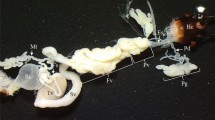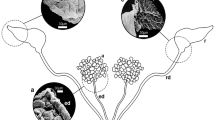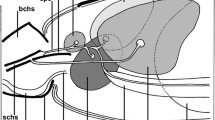Abstract
The salivary glands of Panorpidae usually exhibit distinct sexual dimorphism and are closely related to the nuptial feeding behavior. In this study, the salivary glands of Neopanorpa longiprocessa were investigated using light microscopy and transmission electron microscopy. The salivary glands are tubular labial glands and consist of a scoop-shaped salivary pump, a common salivary duct, and a pair of salivary tubes. The male and female salivary glands are remarkably different in the bifurcation position of the common salivary duct and the length and shape of the secretory tubes. Compared with the simple female salivary glands, the male’s are more developed as their paired elongated salivary tubes can be divided into two parts, the glabrate anterior tube and the posterior tube with many secretory tubules. The ultrastructural study shows that the male salivary tubes have strong secretory function. The existence of different secretion granules indicates that there are some chemical reactions or mixing occurring in the lumen. Based on the ultrastructural characteristics, the functions of the different regions of the salivary tube have been speculated. The relationship between the salivary glands and nuptial feeding behavior of N. longiprocessa has been briefly discussed based on the structure of the salivary glands.







Similar content being viewed by others
References
Ali DW (1997) The aminergic and peptidergic innervation of insect salivary glands. J Exp Biol 200:1941–1949
Azevedo DO, Zanuncio JC, Zanuncio JS Jr, Martins GF, Marques-Silva S, Sossai MF, Serrão JE (2007) Biochemical and morphological aspects of salivary glands of the predator Brontocoris tabidus (Heteroptera: Pentatomidae). Braz Arch Biol Technol 50:469–477
Berhanu A, Abera A, Nega D, Mekasha S, Fentaw S, Assefa A, Gebrewolde G, Wuletaw Y, Assefa A, Dugassa S, Tekie H, Tasew G (2019) Isolation and identification of microflora from the midgut and salivary glands of Anopheles species in malaria endemic areas of Ethiopia. BMC Microbiol 19:85
Beutel RG, Friedrich F, Hörnschemeyer T, Pohl H, Hünefeld F, Beckmann F, Meier R, Misof B, Whiting MF, Vilhelmsen L (2011) Morphological and molecular evidence converge upon a robust phylogeny of the megadiverse Holometabola. Cladistics 27:341–355
Billen J, Joye L, Leuthold RH (1989) Fine structure of the labial gland in Macrotermes bellicosus (Isoptera, Termitidae). Acta Zool 70:37–45
Bockwinkel G, Sauer KP (1994) Resource dependence of male mating tactics in the scorpionfly, Panorpa vulgaris (Mecoptera, Panorpidae). Anim Behav 47:203–209
Byers GW, Thornhill R (1983) Biology of the Mecoptera. Annu Rev Entomol 28:203–228
Castellanos N, Martínez LC, Silva EH, Teodoro AV, Serrão JE, Oliveira EE (2017) Ultrastructural analysis of salivary glands in a phytophagous stink bug revealed the presence of unexpected muscles. PLoS One 12:e0179478
Chapman RF (1998) The insect: structure and function, 4th edn. Cambridge Univ. Press, Cambridge
Cossolin JFS, Martínez LC, Pereira MJB, Vivan LM, Bozdoğan H, Fiaz M, Serrão JE (2019) Anatomy, histology, and ultrastructure of salivary glands of the burrower bug, Scaptocoris castanea (Hemiptera: Cydnidae). Microsc Microanal 25:1–9
Dallai R, Mercati D, Mashimo Y, Machida R, Beutel RG (2017) The morphology and ultrastructure of salivary glands of Zoraptera (Insecta). Arthropod Struct Dev 46:508–517
Del Bene G, Cavallo V, Lupetti P, Dallai R (1999) Fine structure of the salivary glands of Heliothrips haemorrhoidalis (Bouché) (Thysanoptera: Thripidae). Int J Insect Morphol Embryol 28:301–308
Engels S, Sauer KP (2006) Resource-dependent nuptial feeding in Panorpa vulgaris: an honest signal for male quality. Behav Ecol 17:628–632
Engels S, Sauer KP (2008) A secondary sex trait under construction: age- and nutrition-related salivary gland development in a scorpionfly (Insecta: Mecoptera). J Zool Syst Evol Res 46:133–136
Engqvist L, Sauer KP (2001) Strategic male mating effort and cryptic male choice in a scorpionfly. Proc R Soc Lond B 268:729–735
Friedrich F, Pohl H, Beckmann F, Beutel RG (2013) The head of Merope tuber (Meropeidae) and the phylogeny of Mecoptera (Hexapoda). Arthropod Struct Dev 42:69–88
Hidayah ASN, Wahida ON, Shafinaz MNN, Idris AG (2013) Morphology of salivary gland and distribution of dopamine and serotonin on red palm weevil (RPW), Rhynchophorus ferrugineus (Coleoptera: Curculionidae). AIP Conf Proc 1571:345–348
Hua BZ, Chou I (1997) The Panorpidae (Mecoptera) of Funiu Mountain in Henan Province. Entomotaxonomia 19:273–278
Krenn HW (2007) Evidence from mouthpart structure on interordinal relationships in Endopterygota? Arthropod Syst Phyl 65:7–14
Kumar D, Yadav PR, Venugopal KJ, Singh AK (1995) Studies on the salivary glands of an aquatic bug, Lethocerus Indicus (Belostomatidae): morphological, histological and preliminary electron microscopic investigations. Int J Trop Insect Sci 16:51–61
Li N, Hu G-L, Hua B-Z (2019) Complete mitochondrial genomes of Bittacus strigosus and Panorpa debilis and genomic comparisons of Mecoptera. Int J Biol Macromol 140:672–681
Liu SY, Hua BZ (2010) Histology and ultrastructure of the salivary glands and salivary pumps in the scorpionfly Panorpa obtusa (Mecoptera: Panorpidae). Acta Zool 91:457–465
Ma N, Hua BZ (2011) Structural evidence why males of Panorpa liui offer prey rather than salivary mass as their nuptial gift. Acta Zool 92:398–403
Ma N, Liu SY, Hua BZ (2011) Morphological diversity of male salivary glands in Panorpidae (Mecoptera). Eur J Entomol 108:493–499
Martínez LC, do Carmo Queiroz Fialho M, Zanuncio JC, Serrão JE (2014) Ultrastructure and cytochemistry of salivary glands of the predator Podisus nigrispinus (Hemiptera: Pentatomidae). Protoplasma 251:535–543
Martínez LC, Zanuncio JC, Morais WCC, Plata-Rueda A, Cedeño-Loja PE, Serrão JE (2015) Ultrastructure of the salivary glands of the stink bug predator Podisus distinctus. Microsc Microanal 21:1514–1522
Miao Y, Wang J-S, Hua B-Z (2019) Molecular phylogeny of the scorpionflies Panorpidae (Insecta: Mecoptera) and chromosomal evolution. Cladistics 35:385–400
Misof B, Liu S, Meusemann K, Peters RS, Xin Z (2014) Phylogenomics resolves the timing and pattern of insect evolution. Science 346:763–767
Morrison MN (1989) Gel electrophoretic studies with reference to functional morphology of the salivary glands of Acanthaspis pedestris Stål. (Insecta: Heteroptera: Reduviidae). Proc Indian Acad Sci (Anim Sci) 98:167–173
Nelson DL, Cox MM (2017) Lehninger principles of biochemistry, 7th edn. W. H. Freeman, New York
Palmer CM (2010) Diversity of feeding strategies in adult Mecoptera. Terr Arthropod Rev 3:111–128
Potter E (1938) The internal anatomy of the order Mecoptera. Trans R Entomol Soc Lond 87:467–501
Ramm C, Wayadande A, Baird L, Nandakumar R, Madayiputhiya N, Amundsen K, Donze-Reiner T, Baxendale F, Sarath G, Heng-Moss T (2015) Morphology and proteome characterization of the salivary glands of the western chinch bug (Hemiptera: Blissidae). J Econ Entomol 108:2055–2064
Sahayaraj K, Kanna AV, Kumar SM (2009) Gross morphology of feeding canal, salivary apparatus and digestive enzymes of salivary gland of Catamirus brevipennis (Servile) (Hemiptera: Reduviidae). J Entomol Res Soc 12:37–50
Sauer KP, Lubjuhn T, Sindern J, Kullmann H, Kurtz J, Epplen C, Epplen JT (1998) Mating system and sexual selection in the scorpionfly Panorpa vulgaris (Mecoptera: Panorpidae). Naturwissenschaften 85:219–228
Schin K, Kroeger H (1980) (Na+ + K+)-ATPase activity in the salivary gland of a dipteran insect, Chironomus thummi. Insect Biochem 10:113–117
Serrão JE, Castrillon MI, dos Santos-Mallet JR, Zanuncio JC, Gonçalves TCM (2008) Ultrastructure of the salivary glands in Cimex hemipterus (Hemiptera: Cimicidae). J Med Entomol 45:991–999
Thornhill R (1981) Panorpa (Mecoptera: Panorpidae) scorpionflies: systems for understanding resource-defense polygyny and alternative male reproductive efforts. Annu Rev Ecol Syst 12:355–386
Uceli L, Pirovani V, Vicente N, Pikart T, Ferreira PS, Serrão J (2011) Morphology of the reproductive and digestive tracts of Adparaproba gabrieli (Heteroptera: Miridae). Int J Trop Insect Sci 31:219–224
Walker GP (2009) Chapter 228 – salivary glands. In: Resh VH, Cardé RT (eds) Encyclopedia of insects, 2nd edn. Academic Press, San Diego, pp 897–901
Whiting MF (2002) Mecoptera is paraphyletic: multiple genes and phylogeny of Mecoptera and Siphonaptera. Zool Scr 31:93–104
Zhong W, Hua B-Z (2013) Mating behaviour and copulatory mechanism in the scorpionfly Neopanorpa longiprocessa (Mecoptera: Panorpidae). PLoS One 8:e74781
Zhong W, Qi ZY, Hua BZ (2015) Atypical mating in a scorpionfly without a notal organ. Contrib Zool 84:305–315
Zhu YC, Yao J, Luttrell R (2016) Identification of genes potentially responsible for extra-oral digestion and overcoming plant defense from salivary glands of the tarnished plant bug (Hemiptera: Miridae) using cDNA sequencing. J Insect Sci 16:60
Acknowledgments
The authors are grateful to Ji-Shen Wang (Northwest A&F University, Yangling, China) for assistance in species identification. Our manuscript was greatly improved by critical reviews of Prof. Bao-zhen Hua (Northwest A&F University, Yangling, China) and two anonymous reviewers. We also thank Ning Sun, Xiang-Hua Liu, and Cai-Li Zhang (Henan University of Chinese Medicine) for the technical assistance in TEM.
Funding
This research was supported by the National Natural Science Foundation of China (grant nos. 31672346 and 31401989).
Author information
Authors and Affiliations
Corresponding author
Additional information
Handling Editor: Margit Pavelka
Publisher’s note
Springer Nature remains neutral with regard to jurisdictional claims in published maps and institutional affiliations.
Rights and permissions
About this article
Cite this article
Ma, N., Zhang, YX. & Yue, C. The histology and ultrastructure of the salivary glands of Neopanorpa longiprocessa (Mecoptera: Panorpidae). Protoplasma 258, 59–69 (2021). https://doi.org/10.1007/s00709-020-01549-2
Received:
Accepted:
Published:
Issue Date:
DOI: https://doi.org/10.1007/s00709-020-01549-2




